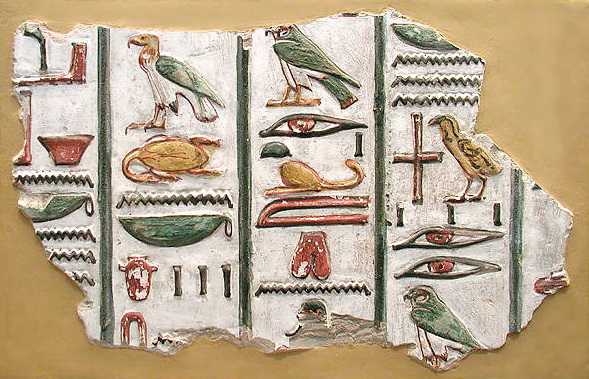
Evolution of Writing
Hieroglyphics
As you progress in your studies, do you find yourself wondering why the Hebrew abgad (alphabet) has no vowels? Who came up with that, and what were they thinking! Hebrew “expects” you to fill in the vowel blanks to decode words you’ve never seen before. What?
 The answers to these questions can be traced back to ancient Egypt where, between the 32nd century BCE and the 4th century BCE, hieroglyphs were the primary writing system. Yes, for a mind-blowing 3000 years, hieroglyphics were the dominant writing system.
The answers to these questions can be traced back to ancient Egypt where, between the 32nd century BCE and the 4th century BCE, hieroglyphs were the primary writing system. Yes, for a mind-blowing 3000 years, hieroglyphics were the dominant writing system.
Hieroglyphs are not an alphabet in the modern sense. Rather, they are a hefty collection of:
- Logographs: Symbols that represent entire words, similar to most Chinese characters today
- Syllabaries: Symbols that represent entire syllables
- Alphabetic: Symbols that represent individual phonemes, similar to most English characters today
The Birth of the Abgad
Sometime between 1850 BCE and 1550 BCE, the people of Canaan (homeland of the Hebrews, aka the Israelites) adapted and simplified Egypt’s hieroglyph system into a revolutionary, simple, and much lighter writing system to express their own language, leading to the development of the Canaanite abgad. We imagine that the Canaanites did not give a second thought to vowels. After all, if powerful, educated Egyptians had gotten along without vowels for thousands of years…
Consider what a technological leap forward this was: The Canaanite 22-letter writing system is exponentially easier and quicker to learn and use than hundreds of complex Egyptian symbols, For the first time in history, writing is accessible to all. The Canaanite 22-character set is referred to as an abgad—an alphabet made up of only consonants.
The Hebrew Abgad
We call the Hebrew abgad by its first two letters, the Alef Bet. Alef is Hebrew’s first letter and Bet is the second. The Alef Bet‘s been going strong for thousands of years, with its letter shapes evolving to meet the needs of its users.
Replacing the original Paleo Hebrew abgad, the more contemporary Maalouli Aramaic or square Assyrian writing was introduced the 4th century BCE. And it is this abgad that most of us recognize as modern Hebrew characters. Square Assyrian writing was adopted by mainstream Jews, but Israel’s Samaritan* community continues to use the Hebrew’s original Paleo form. How cool is that!
______________
* Samaritans—Israelites indigenous to the Shomron (in English “Samaria”) region in the heart of Israel—splintered off from mainstream Judaism back in the 4th century CE and persist in worshipping according to what they believe to be the one true Jewish religion, using the five unedited books of the Torah. Today’s Samaritans retain the priesthood and other elements of Judaism that had been modified or eliminated by Ezra’s reforms to Judaism.
Influence on Modern Alphabets
The influence of the abgad extends far beyond its origins in ancient Canaan. The Greek alphabet, adapted from the Phoenician script around the 9th century BCE, became the basis for the Latin, Cyrillic, Coptic, Gothic, and Armenian alphabets. The Latin alphabet is used by many languages today, including English, Spanish, and French. The Cyrillic alphabet is used for Slavic languages like Russian and Bulgarian.